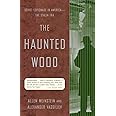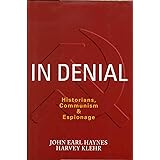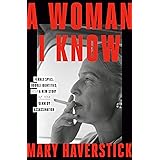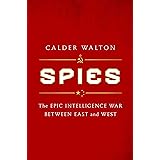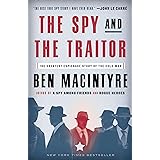Buy new:
-48% $23.25$23.25
Save with Used - Good
$9.48$9.48
Ships from: Amazon Sold by: ZBK Wholesale





Download the free Kindle app and start reading Kindle books instantly on your smartphone, tablet, or computer - no Kindle device required.
Read instantly on your browser with Kindle for Web.
Using your mobile phone camera - scan the code below and download the Kindle app.

Follow the authors
OK
Spies: The Rise and Fall of the KGB in America Paperback – February 23, 2010
Purchase options and add-ons
An unprecedented exposé of Soviet espionage in the United States during the 1930s and 40s
This stunning book, based on KGB archives that have never come to light before, provides the most complete account of Soviet espionage in America ever written. In 1993, former KGB officer Alexander Vassiliev was permitted unique access to Stalin-era records of Soviet intelligence operations against the United States. Years later, living in Britain, Vassiliev retrieved his extensive notebooks of transcribed documents from Moscow. With these notebooks John Earl Haynes and Harvey Klehr have meticulously constructed a new, sometimes shocking, historical account.
Along with general insights into espionage tactics and the motives of Americans who spied for Stalin, Spies resolves specific, long-seething controversies. The book confirms, among many other things, that Alger Hiss cooperated with Soviet intelligence over a long period of years, that journalist I. F. Stone worked on behalf of the KGB in the 1930s, and that Robert Oppenheimer was never recruited by Soviet intelligence. Spies also uncovers numerous American spies who were never even under suspicion and satisfyingly identifies the last unaccounted for American nuclear spies. Vassiliev tells the story of the notebooks and his own extraordinary life in a gripping introduction to the volume.
- Print length650 pages
- LanguageEnglish
- PublisherYale University Press
- Publication dateFebruary 23, 2010
- Dimensions9.2 x 6.32 x 1.79 inches
- ISBN-100300164386
- ISBN-13978-0300164381
The Amazon Book Review
Book recommendations, author interviews, editors' picks, and more. Read it now.
Frequently bought together
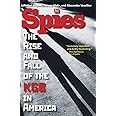
Customers who viewed this item also viewed
Editorial Reviews
Review
?This work should serve as the final salvo in the long battle between those who are still in denial regarding KGB espionage in America in the 1930s and 40s and those who assert that this story must be told. David Murphy, author of What Stalin Knew -- David Murphy
"So outstandingly authoritative and convincing is this material that it will take an honored place alongside the basic sources on Soviet espionage in the United States. Here, the heart of the KGB is laid out as never before."?Tennent Bagley, author of Spy Wars -- Tennent Bagley
"Using now available Soviet sources, this valuable book tells the sobering and frightening story of the extent to which ideology will blind clever people and lead them to betray their country, democracy and freedom."?Paul Johnson, author of A History of the American People -- Paul Johnson
"An original and important book based on scholarship of the highest standards."-Hayden B. Peake, former Army and CIA intelligence officer -- Hayden B. Peake
"This work should serve as the final salvo in the long battle between those who are still in denial regarding KGB espionage in America in the 1930s and 40s and those who assert that this story must be told."-David Murphy, author of What Stalin Knew
About the Author
Product details
- Publisher : Yale University Press; First PB Edition, First Printing (February 23, 2010)
- Language : English
- Paperback : 650 pages
- ISBN-10 : 0300164386
- ISBN-13 : 978-0300164381
- Item Weight : 1.75 pounds
- Dimensions : 9.2 x 6.32 x 1.79 inches
- Best Sellers Rank: #1,131,710 in Books (See Top 100 in Books)
- #693 in Espionage True Accounts
- #1,445 in Political Intelligence
- #2,524 in Russian History (Books)
- Customer Reviews:
About the authors

John Earl Haynes
John Earl Haynes is Modern Political Historian in the Manuscript Division of the Library of Congress, Washington, DC, USA. He received his Ph.D. in 1978 from the University of Minnesota and a B.A. from Florida State University in 1966.
Dr. Haynes is the author or editor of eleven books:
Spies: the Rise and Fall of the KGB in America (coauthors Harvey Klehr and Alexander Vassiliev, Yale University Press, 2009)
Early Cold War Spies: the Espionage Trials that Shaped American Politics (coauthor H. Klehr, Cambridge University Press, 2006)
In Denial: Historians, Communism and Espionage (coauthor H. Klehr, Encounter Books, 2002)
Venona: Decoding Soviet Espionage in America (coauthor H. Klehr, Yale University Press, 1999)
Calvin Coolidge and the Coolidge Era: Essays on the History of the 1920s (editor, Library of Congress and the University Press of New England, 1998)
The Soviet World of American Communism (coauthors H. Klehr and Kyrill Anderson, Yale University Press, 1998)
Red Scare or Red Menace? American Communism and Anticommunism in the Cold War Era (Ivan Dee Pub., 1996)
The Secret World of American Communism (coauthors H. Klehr and Fridrikh Firsov, Yale University Press, 1995)
The American Communist Movement: Storming Heaven Itself (coauthor H. Klehr, Twayne Pub., 1992)
Communism and Anti-Communism in the United States: An Annotated Guide to Historical Writings (Garland Pub., 1987, editor and compiler)
Dubious Alliance: The Making of Minnesota’s DFL Party (University of Minnesota Press, 1984)
He has also authored more than seventy-two published articles and essays.
Dr. Haynes is also a member of the editorial boards of the journals "American Communist History", "The International Newsletter of Communist Studies", and the "Jahrbuch für Historische Kommunismusforschung" as well as on-line editor of the historical discussion list on American communism, H-HOAC. He was the Library of Congress’s historical representative to the Incomka Project (International Committee for the Computerization of the Comintern Archive). His web site is: johnearlhaynes.org
In addition to his historical activities, Dr. Haynes has served as the Assistant Commissioner for Tax Policy in the Revenue Department of the State of Minnesota, aide to two Minnesota governors and one U.S. Senator and one U.S. Representative from Minnesota, and researcher for a caucus of the Minnesota State Senate.

Discover more of the author’s books, see similar authors, read author blogs and more
Customer reviews
Customer Reviews, including Product Star Ratings help customers to learn more about the product and decide whether it is the right product for them.
To calculate the overall star rating and percentage breakdown by star, we don’t use a simple average. Instead, our system considers things like how recent a review is and if the reviewer bought the item on Amazon. It also analyzed reviews to verify trustworthiness.
Learn more how customers reviews work on Amazon-
Top reviews
Top reviews from the United States
There was a problem filtering reviews right now. Please try again later.
Much of the evidence presented in the book is drawn from the notebooks of the Russian journalist Alexander Vassiliev. In 1993 Vassiliev was granted limited access to the KGB's operational files for the 1930s and 1940s. His transcripts of pages from these files would eventually fill 8 notebooks comprising more than 1000 pages. Summaries of the documents were used in writing the book "The Haunted Wood (1998)," which Vassiliev co-authored with Allen Weinstein. In a lengthy introduction to "Spies," Vassiliev tells the story of his notebooks and his defamation suit against the publisher Frank Cass. He also paints a sympathetic portrait of the American spies, whom he views as heroes, which helps to counterbalance the more severe portrait painted by Haynes and Klehr.
The authors open the book by revisiting the Hiss case in a chapter subtitled "Case Closed." Aside from conspiracy theorists for whom there exists no untainted Hiss evidence, it seems impossible not to agree with the authors' contention that Hiss was a committed communist and a Red Army (GRU) source until his exposure in 1948. Some of the evidence in this chapter was documented earlier by Vassiliev in the "Haunted Wood," and the lengthier treatment given here by Haynes and Klehr fully corroborates the sixty-year-old testimony of Hede Massing and Whittaker Chambers. The authors cite new evidence from the KGB files of Michael Straight and Lawrence Duggan which confirms Hiss's bona-fides as a GRU agent. They also argue persuasively, using both Venona and Vassiliev material, that Hiss was the agent cover named JURIST, LEONARD, and ALES; and they supply the likely identity of the party worker, cover named PAUL, who became Hiss's liaison with the GRU following Whittaker Chamber's defection.
For readers interested in the atom-bomb spies, the book is a treasure-trove of new information. The Venona decrypts exposed the damaging Los Alamos spies MLAD (Theodore Alvin Hall) and STAR (Saville Sax), but researchers were unable to identify all the people behind the cover names in the decrypted Soviet cables. The masks have now been ripped from the faces of these spies. The authors reveal the name of PERS/FOGEL, an engineer recruited into espionage by Julius Rosenburg; the name of QUANTUM, a foriegn scientist who, in exchange for money, delivered atomic information to the Soviet Embassy in Washington D.C.; the name of ERIC, a refugee Austrian physicist at the Cavendish Laboratory who provided atomic research to the Soviets in Great Britain; and the name of RELE/SERB, the crippled Spanish Civil War veteran who supplied technical data on sonar. After sifting the evidence, the authors conclude that Robert Oppenheimer was a concealed member of the CPUSA in the late 30s, but that he distanced himself from the party and did not supply information to the KGB. Unfortunately, Vassiliev was granted access to only a single file pertaining to atomic espionage and the authors can shed no new light on the continuing debate about whether the Soviets obtained the secret of the hydrogen bomb from penetration agents.
The chapters on the U.S. government and the OSS corroborate the testimony of Elizabeth Bentley, the "Red Spy Queen," and supplement the voluminous FBI "Silvermaster File." The names of many heretofore unknown secret KGB agents are also revealed. Certainly two of the most interesting and colorful are LEO, an immigrant journalist, and WILLY, the Director of the Bureau of Indexes and Archives at the State Department. This mercenary pair engaged in a racket selling copies of State Department cables to the KGB for money. When they pretended to recruit a third agent and asked the KGB for a larger sum, their greed was discovered. The pair had a falling out and their names disappear from the KGB files, though in a curious twist of fate, WILLY would later appear as a government expert in the Hiss case. The authors expose spy after spy and it is by this slow, mounting presentation of evidence that the reader is led to the conclusion that far more Americans, operating on a far larger scale than had been previously imagined, conspired with the KGB in the 1930-40s. The apparatus employed Americans as couriers, talent spotters, watchers, journalists, bagmen, legitimate fronts, photographers, and agent handlers. There were hundreds of Americans who secretly abetted Stalin's KGB.
To meet the needs of Stalin's policy of forced industrialization, the KBG actively recruited spies with technical/scientific information. Some acted as paid informants, while others, such as the Rosenburgs, were motivated by ideology. The past two decades have not been kind to Rosenburg defenders. In 1995 the Venona decrypts identified Julius as the Soviet spy with the cover names LIBERAL and ANTENNA; in 2001 Alexander Feklisov, the Rosenburg's Soviet handler, published "The Man Behind the Rosenburgs;" and in September 2008 Rosenburg accomplice Morton Sobell, after decades of denial, confessed that he was an active participant in Julius's spy apparatus. Haynes and Klehr add to our knowledge of the Rosenburg apparatus by exposing the agents PERS and TUK, and by pointing out that Rosenburg agents YAKOV, METER, and HUGHES delivered an extraordinary cache of classified technical information to the Soviets. The only reasonable act left in this drama is for the Russian government to admit that the Rosenburgs were Soviet spies and to build a monument in their honor.
The book is arranged as a series of topically related biographical sketches and one criticism of Haynes and Klehr is that they do not provide enough context for readers unfamiliar with the ideological landscape of the 1930s. The book does not help us to understand why so many Americans joined the communist party in the 1930s and why a number became witting agents for the Comintern, GRU, and KGB. And it also does not give a clear explanation as to why many of these same people abandoned their communist faith in the years prior to McCarthy's speech at Wheeling. It is ironic that the fortunes of the KBG in American were at their lowest ebb at precisely the moment when the 1950's "Red Scare" began. Readers can gain a greater understanding of the milieu by seeking out Vivian Gornick's "The Romance of American Communism" or Whittaker Chamber's autobiography "Witness."
For many years, "Spies" will remain the definitive history of the golden-age of Soviet espionage in America.
This book is unique, however, in that it was the result of a very brief, very special, very rare period of openness right after the Cold War ended when the KGB uncharacteristically experimented with openness. At that point, the leadership of the KGB decided to open their files to tell the story of Soviet spy operations in America. Originally, they planned to produce at least 3 books on real KGB operations in America from the 30s-50s, a period of time that is recent enough to be very interesting to American readers, yet long enough ago that nobody actually involved was likely to still be alive.
This unheard-of access was only permitted because the reporter was a former KGB agent, himself, who was considered reliable. The KGB tried to limit what the reporter had access to, but the poor organization of their old files prevented them from exercising much control over what he saw. He stated one of the KGB's fundamental policies is to never confirm a source who hasn't already confessed his involvement with the KGB. That's their commitment to their spies, even if they've been caught, and why many tantalizing files were denied him. For the files that were off-limits, he found an alternate route to the information by using the old Communist Party USA (CPUSA) files, which are also stored in Moscow. He also used the Venona Papers, thousands of partially-decrypted US and allied intercepts of Soviet communications from the 1940s.
The results of this exhaustive research is a very rare look at the Soviet side of espionage during and after WWII in the early Cold War. The topics are fascinating, such as the Manhattan Project and the Rosenbergs, Soviet spies in the State Dept, Soviet penetration of the OSS at nearly all levels, Congressman Dickstein, who approached the Soviets to trade his inside knowledge and votes for money, and the Soviets' extensive technical and military technology spying. If things had been different in the early 1990s, we might have seen more information come out, but the new feelings of openness quickly hardened and institutional paranoia returned and the author felt compelled to flee Russia for his own safety. His notes were, thankfully, smuggled out and published in this book.
Finally, we can see what the Soviets had on Alger Hiss and Whitaker Chambers, Julius and Ethel Rosenberg, famous reporters, like I.F. Stone, and even the Soviet files on Ernest Hemingway (did you know he was a named KGB source?!). The source is unimpeachable; it's the KGB's own files. This makes the book rather exciting and provocative-it names the names and settles the furor from the 1950s anti-Communist trials that has been a source of bitter contention for decades. Despite what die-hard believers think, Alger Hiss was a traitor. You can read his handler's notes on his ham-handed interactions with other "Fellow Travelers." You can read the KGB notes on the damage Elizabeth Bentley and Whitaker Chambers were doing to their operations, which ultimately helped wreck Soviet operations in the US for years afterwards. You can read their detailed instructions on how to recognize each other and what codewords they used, their psychological studies of their sources, and how they conducted operations.
I found the book very dry at times. It is not an exciting action-thriller, but a factual discussion of who did it, how they did it, what they did, and what happened afterwards. It frequently repeats material regarding the same spy rings in different sections and chapters. Since one spy ring might have several high-profile spies, i.e. the Rosenberg Ring, it's unavoidable that information from Julius' operations might be repeated in Ethel's section. That same information might crop up again in another chapter when their handler is discussed in another operation. The authors were exhaustive in providing the facts to clear up the mysteries. While this makes the book great history, it also makes for some dry parts.
One of the maddening aspects of the book was the almost Keystone Cops quality of the US counterintelligence operations of that period. US security organizations were not very effective or organized in this period. The OSS, for instance, didn't even care if they hired known Communist agents if they could help fight Fascists. Worse, the FBI's own counterintelligence operation was penetrated by a spy for some time, who passed on all their suspects and operations to the KGB. The only area the government really tried to root out Communist spies was the Manhattan Project, and they were fairly good at it for a while.
Reading the KGB's own descriptions of the amateurish, careless, risky actions of these high-profile spies and their sometimes entire lack of discretion is only less shocking than the fact they were almost never caught. Alger Hiss, for instance, practically told everyone he met who lefty he was a spy. He even tried to recruit others who were already-recruited Soviet agents, creating headaches for their handlers. One young newly-recruited KGB agent just starting at the Dept. of State spotted Hiss immediately as a spy, despite not knowing him or his status. If this kid could tell, how in blazes did the intelligence services not catch him for so long?!?
Also fascinating was reading just how far the Soviets controlled the Communist Party USA (CPUSA). They owned it from top to bottom. That may seem obvious to people now, but at the time, many American Communists had no idea they were effectively supporting the USSR. The CPUSA acted as a talent spotting operation and sometime support service for the Soviets, helping connect potential sources to the KGB, running operations and spies for the KGB, and transferring entire networks of recruits to the KGB. Many spies originally thought they were merely helping the CPUSA and the KGB was slow to explain where their reports actually went. Agents noted some recruits figured out where their reports were going, especially when tasked with targeting data of value to Moscow.
Something else I found interesting was how loosely-organized these operations could be. The KGB had a very hard time controlling their agents, controlling their sources, and getting them to follow orders or use practical tradecraft. Some spies dutifully, even exhaustively, worked to get every document, photo, and detail they could. Some stole so many documents, the KGB had to issue them a full-time assistant just for taking photographs and writing messages for transmit to Moscow. Others were unreliable, failed to attend their own meetings, refused to follow instructions, and in at least one case, even invented their own sub-sources to cheat the KGB out of additional pay.
Also interesting was reading the author's comments on how he sees these people. Here, in America, it is perfectly legitimate to consider them the lowest form of traitors and scumbags, while to a Russian patriot and sometime KGB agent, like the author, these people were heroes who bravely faced prison and universal public condemnation to help his country against the Nazis and the anti-Russian US Government. He defends them as patriots who saw a greater duty than to their own nation, or who felt the Communist system was the only balance to the US' superpower status, or who thought the USSR was the only nation working for true international peace. I don't agree at all with these views, but it's interesting to see someone else presenting them as a total outsider in our own culture.
If you are interested in topics, like the KGB, Soviet intelligence in general, Soviet spies in America, and what really happened in the "Red Terror" of the 1950s, this book will probably interest you. It is a scholarly work, not fiction or politically-motivated propaganda for either side of the still-contentious debate on 1950s Communist traitors in America. If spy books interest you, this weighty tome should be a welcome addition to your bookshelf.
Top reviews from other countries
1. The Rosenbergs were spies
2. McCarthy may have been a self-serving blow-hard but he was right
Tough read for 'Progressives'.




